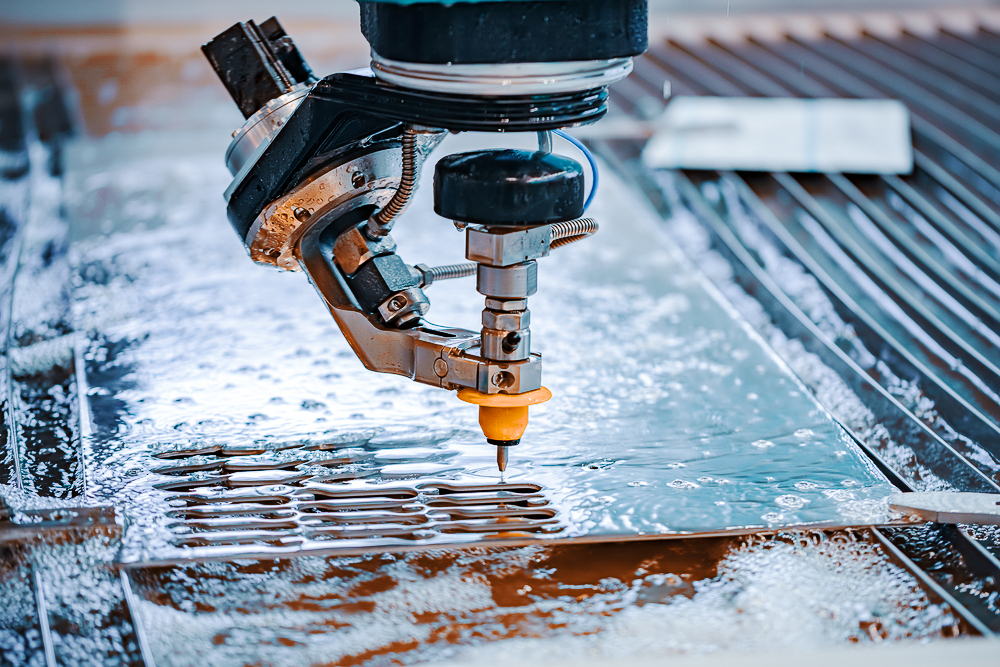The Basics: What is Waterjet Cutting?
Waterjet cutting stands out as a cutting process that uniquely leverages a high-pressure water stream, allowing it to effortlessly slice through diverse materials. This technique, not only reserved for metals, finds its utility in cutting everything from glass and stone to various composites. Its impressive adaptability has seen its implementation spread across industries as varied as aerospace, art, and the automotive sector.
Where other cutting techniques such as laser cutting may fall short, waterjet cutting shines, demonstrating its unique capability to manage an impressive array of materials with unparalleled precision and ease. From robust metals to intricate designs in delicate materials like glass or stone, waterjet cutting has consistently proven its efficiency and effectiveness.
Demystifying the Process: How Does Waterjet Cutting Work?
Behind the impressive capability of waterjet cutting machines lies the power of a high-pressure pump. This pump propels water through a specially designed nozzle, creating a water stream that reaches supersonic speeds. To further augment its cutting power, an abrasive substance, often garnet sand, is mixed with the water. This high-velocity water-abrasive mixture is then guided onto the target material, eroding it slowly but consistently until the precise cut is achieved.

Understanding how waterjet cutting works is crucial to appreciating its advantages. It’s a fascinating blend of physics and engineering, where water’s natural properties are harnessed and amplified to create a cutting tool that’s both powerful and precise.
Why Opt for Waterjet Cutting?
When compared with conventional cutting methods such as laser and plasma cutting, waterjet cutting offers several distinct advantages:
Matchless Versatility
In contrast to the limitations often associated with laser and plasma cutting, waterjet cutting excels at processing a wide range of materials, from metals and plastics to ceramics and glass.
Precision at Its Best
The precision offered by waterjet cutting is remarkable. It can achieve tolerances as tight as +/- 0.005, a level of accuracy that’s often beyond the reach of other cutting techniques.
Heat-Free Cutting Process
As it doesn’t generate heat, waterjet cutting ensures that materials remain undamaged and unwarped. This is a significant advantage over heat-generating methods that can distort or damage the material being cut.
Smooth, Burr-Free Outputs
The cuts produced by waterjet cutting are free of burrs, eliminating the need for additional finishing processes.
Cold Cutting Excellence
This method protects the inherent properties of the material being cut, ensuring there’s no alteration due to heat.

The Mechanics: Deconstructing the Functioning of Waterjet Cutting
At the heart of this extraordinary process is a high-pressure pump, which is responsible for driving the water through a specifically engineered nozzle, resulting in a water stream that attains supersonic speeds. To further enhance its cutting prowess, the system introduces an abrasive substance, typically garnet sand, into the water stream. This potent mixture of high-velocity water and abrasive material is then directed onto the target material, eroding it steadily yet effectively, until the desired cut is accomplished.
A comprehensive understanding of the waterjet cutting mechanism is key to appreciating its numerous benefits. It’s a remarkable confluence of physics and engineering, where the inherent properties of water are exploited and magnified to create a cutting tool that is simultaneously powerful and precise.
The Cutting Head: The Core of Waterjet Cutting
The cutting head plays a pivotal role in the waterjet cutting process. It is here that the ultra-high-pressure water combines with the abrasive to form a potent cutting agent. The cutting head focuses this mixture, allowing it to cut through materials with exceptional precision. The size and speed of the cutting head can be adjusted to achieve varying levels of detail and speed, making it an incredibly versatile tool.
In conclusion, waterjet cutting is a multifaceted process that offers unparalleled versatility and precision in cutting a wide range of materials. Whether for industrial applications or artistic endeavors, its benefits are numerous, making it a preferred choice over other techniques like laser cutting.
If you’re seeking a cutting technique that offers precision, versatility, and adaptability across a wide array of materials, waterjet cutting is a top contender. Its edge over traditional methods makes it an invaluable asset across various industries, proving its worth in diverse applications and settings.
